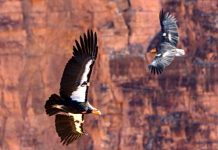SALT LAKE CITY, Utah, June 3, 2024 (Gephardt Daily) — The Utah Department of Wildlife Resources is reminding people that we share the state with as many as 3,000 moose, and with adults weighing between 600 and 1,000 pounds, they are going to win any fight they believe we started.
Moose are typically gentle vegetarians, but when they feel threatened and charge, they can present a serious danger to humans in their habitat.
“In my years of working with wildlife, I have dealt with bears, rattlesnakes, cougars and moose, and the only species that I’ve had turn and come back at me was a moose,” said Rusty Robinson, Utah Division of Wildlife Resources Species Coordinator. “Because they are not predators, people often underestimate how aggressive moose can be.”
Moose can act aggressively anytime they feel cornered or threatened, but cows can be especially defensive when they have calves (typically in late May and early June). Bull moose are more territorial and aggressive during the fall breeding season (typically in September).
Moose view dogs as natural predators and feel threatened when they get too close, which can make them very aggressive toward the dog or any people nearby. This can lead them to charge, knock someone over and stomp on them or their dog.
Some physical warning signs that a moose may become aggressive include:
- Lowering their head
- Hair standing up on the neck
- Licking their snout
- Pinning their ears back
If you encounter a moose, here are some tips to help you stay safe:
- Always give the moose a lot of space and watch its behavior.
- Never try to approach or feed a moose.
- Keep dogs leashed and under control at all times. It is against Utah law to allow dogs to chase or harass protected hoofed wildlife, like moose.
- Stay calm and do not run away. Talk, make your presence known and slowly back away in the direction you came.
- If a moose charges you or chases you, hide behind something solid (like a tree) or try to get inside a vehicle or building.
- If a moose knocks you down, curl into a ball, protect your head and lie still until the moose retreats.
“Like with most wildlife, if you give moose plenty of space and don’t try to get too close, it will help keep you and them safe,” Robinson said. “Our biologists relocate numerous moose in urban areas every year, and we really want people to admire these amazing animals from a distance and stay safe. If you are hiking with your dog, we strongly recommend keeping them leashed when you are hiking in mountain areas with moose.”
Video of moose relocation from the Utah Division of Wildlife Resources
Moose are commonly found in the foothill areas since that is their natural habitat. You should report a moose that has wandered into lower-elevation areas and is within city limits or heavily populated areas, so the DWR can relocate the animal.
If moose aren’t relocated, they can stay in an area for a long time and potentially injure someone or damage property. Urban environments, which include fences and vehicles, can be unsafe for moose. Avoid approaching moose or attempting to “herd” them out of yards or roads. Moose can be very aggressive, especially around dogs.
For more moose safety tips, visit the Wild Aware Utah website.





